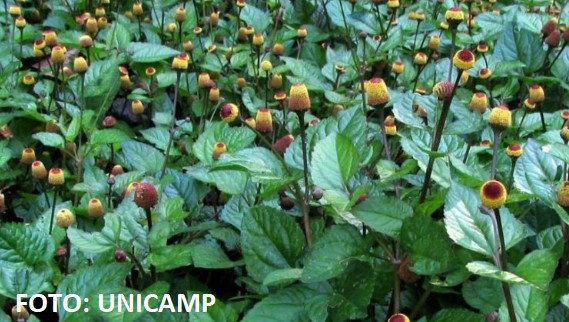The importance of using Acmella oleracea L.
DOI:
https://doi.org/10.20873/jbb.uft.cemaf.v7n4.santosKeywords:
benefit, jambuAbstract
The use of plant species is what maintains the society in several aspects, enjoying the beneficial properties that biodiversity offers, including among them the vegetable Acmella oleracea L. popularly known as Jambu, being nutritional and commercial value, extracted from the flora. In this way, the work aimed to characterize the importance of this species, showing its properties in various sectors as nutritive functions in food and cosmetics. With its use in certain studies, the article sought to establish the main improvements through bibliographic reviews of certain studies among them, articles, master's studies to doctorates, highlighting its importance and how its flavor that caused dormancy was what made it known. With the revisions of these, it was possible to notice that this species of vegetable is well studied, because it has essential substances that the human body needs, among them, vitamins, calcium, iron and others. Its use has brought to the academic study a different and complementary view and seen in other activities carried out here.
References
BERETTA, M.E. et al. A família Asteraceae no Parque Esta-dual de Itapuã, Viamão, Rio Grande do Sul, Brasil. Revista Brasileira de Biociências, Rio Grande do Sul, v.6, n.3, p.189-216, 19 abr. 2009.
CASTRO, K.N.C.; ANHOLETO, L.A. et al. Cytotoxic effects of extract of Acmella oleraceae (Jambu) in rhipicephalusmi-croplus females ticks. Microscopy research and technique. On-line. ago. 2016.
DEMETERCO, C. Slow food brasil Jambú. 2016. Disponível em: <http://www.slowfoodbrasil.com/arca-do-gosto/produtos-do-brasil/1123-jambu>. Acesso em: 16 maio 2019.
HOMMA, A.K.O. et al. Etnocultivo do Jambu para abasteci-mento da cidade de Belém, estado do Pará. Amazonia Cien-cia & Desenvolvimento, Belém, n.6, p.125-141, 12 jun. 2011.
HOMMA, A.K. O. História da agricultura na Amazônia: da era pré-colombiana ao terceiro milênio. Brasília, DF: Em-brapa Informação Tecnológica, 2003. 274 p. Disponível em: http://pt.espacenet.com. Acesso em: 18 mai. 2019.
HOMMA, A.K.O. "Plant extractivism or plantation: what is the best option for the Amazon?" Estudos Avançados. 2012; v.26, n.74, p.167-186.
FREITAS BLANCO, V.S., FRANZ-MONTAN, M. et al. Development and evaluation of a novel mucoadhesive film containing Acmella oleracea extract for oral mucosa topical anesthesia. PLOS ONE. On-line. set. 2016.
KENOBY. Tipos de entrevista: estruturada, semiestruturada e não estruturada. 2019. Disponível em: <http://www.kenoby.com/blog/tipos-de-entrevista/>. Aces-so em: 18 maio 2019.
SILVA, A.A.; ANDRADE, L.H.C. Utilização de espécies de Asteraceae por comunidades rurais do nordeste do Brasil: relatos em Camocim de São Félix, Pernambuco. Biotemas, [s.l.], v.26, n.2, p.94-102, 4 mar. 2013. Universidade Fede-ral de Santa Catarina (UFSC). http://dx.doi.org/10.5007/2175-7925.2013v26n2p93.
MINISTÉRIO DA SAÚDE. Manual operacional para comitês de ética em pesquisa. Brasília: Conselho Nacional de Saúde, 2002.
MOURA, I.O.; GOMES-KLEIN, V.L.; FELFILI, J.M., FERREIRA, H.D. 2010. Diversidade e estrutura comunitá-ria de cerrado sensu stricto em afloramentos rochosos no Parque Estadual, Goiás. Revista Brasileira de Botânica, v.33, n.3, 455-467.
NAKAJIMA, J.N.; PACHECO, R.A. A família Asteraceae na Serra dos Pireneus, Goiás, Brasil. 2014. 181 f. Dissertação (Mestrado) - Curso de Biologia Vegetal, Programa de Pós-graduação, Universidade Federal de Uberlândia, Uberlância, 2014.
POLTRONIERI, M.C., MÜLLER, N.R.M., POLTRONIERI, L.S. Recomendações para a produção de jambu: cultivar Na-zaré. Embrapa Amazônia Oriental, 2000.
STANISKI, A., FLORIANI, N., STRACHULSKI, J. 2014. Estudo etnobotânico de plantas medicinais na comunidade faxinalense Sete Saltos de Baixo, Ponta Grossa – PR. Terr@Plural, v.8, p.321-240.

Published
How to Cite
Issue
Section
License
Copyright (c) 2024 - Journal of Biotechnology and Biodiversity

This work is licensed under a Creative Commons Attribution 4.0 International License.
Authors who publish with this journal agree to the following terms:
Authors retain copyright and grant the journal right of first publication with the work simultaneously licensed under a Creative Commons Attribution License (CC BY 4.0 at http://creativecommons.org/licenses/by/4.0/) that allows others to share the work with an acknowledgement of the work's authorship and initial publication in this journal.
Authors are able to enter into separate, additional contractual arrangements for the non-exclusive distribution of the journal's published version of the work (e.g., post it to an institutional repository or publish it in a book), with an acknowledgement of its initial publication in this journal.
Authors are permitted and encouraged to post their work online (e.g. in institutional repositories or on their website) prior to and during the submission process, as it can lead to productive exchanges, as well as earlier and greater citation of published work (Available at The Effect of Open Access, at http://opcit.eprints.org/oacitation-biblio.html).


